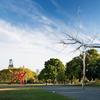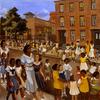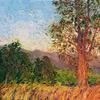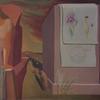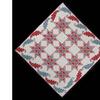Journeys through History: Reflections on Provenance
- January 31, 2023 13:41
Rebuilding the Past
“The moment when a work of art changes hands is sometimes the only point at which it becomes visible.” — Lauren Lessing
Provenance is often described as the history of ownership of an artwork or antique. It has the distinctive privilege of telling the story of how the object traveled from a maker’s workshop to a world-class museum, or from an artist’s studio to a family’s residence. For those historical objects that retain an extensive provenance record, their journey has been preserved for posterity — often as a testament to the immense value and care their owners demonstrated for them. These records of an artwork’s path from the past to the present can also serve the essential role of verifying authenticity or demonstrating historical value. As the Getty Research Institute explains, “A full provenance provides a documented history that can help prove ownership, assign the work to a known artist, and establish the work of art's authenticity.”
It is not uncommon for provenance records to take the form of sales records. As Lauren Lessing wrote in her article “Problems in Provenance Research,” the exchanges of art or an object can document its existence before it once again recedes to a collector’s private collection. In those moments of public record — whether through auction, estate sales, or by descent in an inheritance — the artwork frequently acquires more paperwork. Other times, the people who cherish an antique often choose to leave a mark, whether it be an engraved monogram or a written inscription in a book, to document their love for the object, or more often the people and ideas the object represents. In this way, the objects themselves can tell a story about the hands that have touched them over the years.
Objects that have extensive provenance records are frequently prized for their historicity; they serve as documents of the past and the many hands — whether creator, patron, or collector — that they passed through. Those stories, however, can quickly become muddled by the very same forces of history.
The Difficulties of Provenance
There are times when constructing provenance is not as simple as reviewing auction records and examining inscriptions. The very nature of history — ever-changing, dynamic and seldom lacking in social and political upheaval — can obscure an object’s origin or journey. Documentation may have been destroyed in a natural disaster, or malicious theft may have divorced the object from its original owners. Many objects are lost to the ravages of time, whether sunken under the sea, buried in storage, or destroyed. The mere fact that any objects from the past have survived for us to enjoy today is a cause for celebration.
One such object in our collection whose past remains shrouded in mystery was created over 350 years ago by French sculptor Jean-Baptiste Tuby. Called Le Romain by his peers as a nod to his Italian heritage and training, Tuby had moved to France sometime after 1660 to work under Charles Le Brun. In the decade that followed, Tuby became a leading figure in Baroque sculpture, completing royal commissions for the grottoes of Château de Saint-Germain-en-Laye and the gardens and fountains of Palais de Versailles as favored court sculptor to Louis XIV.
It is believed that the sculptor began a new commission sometime circa 1670 — a pair of two bronze horses full of life and dynamism. Originally envisioned as part of a decorative fountain, the figures represented the mythical hippocampus, or seahorse, as evidenced by their hooves, mane and torso entangled with flowing seaweed. The subject was not new to Tuby; in fact, the work relates closely to an important fountain by Tuby created for the Basin of Apollo at Versailles, depicting the Greek god of the sun pulled in his chariot by a team of horses that bear a striking resemblance. Likewise, the equestrian pair resemble a since-destroyed fountain sculptural group by Tuby for Versailles consisting of two hippocampi surrounded by cupids and spouting water.
The equine duo, however, demonstrates the difficulties that frequently arise when trying to uncover an object’s provenance. It is almost certain that Tuby created the equestrian figures under the commission of King Louis XIV to be housed at his beautiful Château de Marly. Marly, like Versailles, had dozens of beautiful fountains, but the estate went into decline and was dismantled after the French Revolution. Regarded as a symbol of the deposed monarchy, many of the monumental sculptures and fountains at the king’s multitudinous palaces were destroyed by the revolutionaries, and bronzes were melted down in order to produce artillery. The few marble sculptures that survived now reside in the Cour Marly at the Louvre or the preserved Versailles, and the great majority of Marly’s bronzes are missing. The political and social upheaval of France in the 18th century has obscured the equine bronzes’ path through time, making it cumbersome to reconstruct which fountain these sculptures were initially intended for — or how they survived the revolution.
It is unlikely that Tuby, while he sat meticulously sculpting his bronzes and chiseling away at his marbles, imagined a day when the Palais de Versailles or the Château de Marly would fall to revolution and emptied for spoils. It would have been difficult for the French sculptor, working in his 17th-century studio, to envision the number of hands his pair of equine bronze would pass through, and the vast seas they would cross, until the duo’s eventual arrival to M.S. Rau in New Orleans centuries later. Desirable and beautiful in their own right, the provenance and story of Tuby’s horses has yet to be fully uncovered.
Bridging the Gap
The story of Tuby’s beloved hippocampi is not unique in discussions of provenance. War — and comparable forms of unrest and destruction — muddies the water and can make it exceedingly difficult to uncover an object’s true history. In the years following WWII, which saw mass looting of artworks and treasures across Europe, particularly from targeted Jewish families, a great deal of attention and resources were dedicated to essential provenance research. As a response to the uptick in the trafficking of cultural material following the war, the 1970 UNESCO Convention on the Means of Prohibiting and Preventing the Illicit Import, Export and Transfer of Ownership of Cultural Property established essential avenues for the prevention and restitution of stolen goods. Working together, the international community began to limit the black market and repatriate goods seized from their rightful owners.
The new legislation, which has since been adopted by 142 countries worldwide, necessitated innovative pathways to try to uncover more clarity on the origins of objects in the modern museum or market to ensure compliance with the UNESCO Convention. Tools such as the Art Loss Register and the Getty Provenance Index have pioneered new frontiers of documentation and ownership. As researchers continue to explore new techniques and methods to uncover more information about the relics of our past, sometimes we can only imagine the secrets antiques would tell if they could talk.
To read more about objects with exceptional provenance and stories to tell, check out our virtual exhibition Storied Histories!
Citations:
“Collecting and Provenance Research.” The Getty Research Institute, J. Paul Getty Trust, 2023, https://www.getty.edu/research/tools/provenance/.
Lessing, Lauren. “Problems in Provenance Research.” Art Documentation: Journal of the Art Libraries Society of North America, vol. 19, no. 2, 2000, pp. 49–51., https://doi.org/10.1086/adx.19.2.27949088.
“The UNESCO 1970 Convention.” UNESCO, UNESCO, 9 Nov. 2022, https://en.unesco.org/fighttrafficking/1970.






